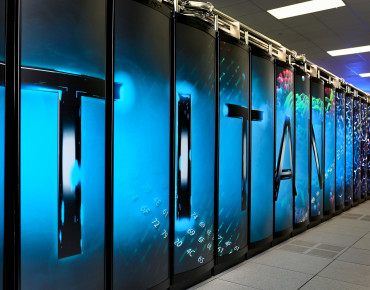Government Labs Give Enterprises a Supercomputing Boost

Oak Ridge Leadership Computing Facility's Titan2 (Source: Oak Ridge)
International conglomerates, tech startups, and SMBs can tap into the federal government's investments in supercomputers and expertise through a series of programs operated by several of the nation's leading NSF funded universities and Department of Energy laboratories.
The three DOE labs running computing centers for the U.S. Department of Energy (DOE) Office of Science/Office of Advanced Scientific Computing Research (ASCR) includes the Argonne Leadership Computing Facility; Oak Ridge Leadership Computing Facility, and the National Energy Research Scientific Computing Center at Lawrence Berkeley National Laboratory.
For enterprises considering investing in high-performance computing, leveraging these powerful computers and the laboratories' knowledge of how to best use these systems often opens their eyes to the potential of this technology, said Suzy Tichenor, director of industrial partnerships at Oak Ridge, during Enterprise HPC in San Diego in May.
"Every company that comes in and runs problems at a larger scale than they could do internally walks away with new insight," she said. "It enables companies to see beyond what they thought was possible.
General Electric, for example, worked with Argonne National Laboratory and Oak Ridge Laboratory on multiple projects including modeling for a windmill blades and jet engines, said David Martin, manager of industry partnerships and outreach for the Leadership Computing Facility at Argonne. "A few years ago they bought their own Cray," he said. "There's no way they would have bought that without this experience."
The NSF-funded National Center for Supercomputing Applications (NCSA) at the University of Illinois has an Industry and Economic Development program, led by . The program has worked with more than one third of the Fortune 50, and its Private Sector Program includes 26 partners. The primary goal of this program is to help partners gain a competitive edge through "expert use of modern, high-performance digital and human resources."
Powerful Allies
The labs have extensive investments in powerful technology but, even more importantly, provide enterprises with access to troves of knowledgeable individuals who help resolve business challenges. Labs have a variety of contracts to put business executives' minds at ease, allowing the free flow of information and ideas, and the option of licensing certain technologies from the centers.
Each facility has an impressive array of technologies available. Oak Ridge is home to the Titan Cray XK7, the Department of Energy’s most powerful supercomputer with a theoretical peak performance exceeding 27 quadrillion operations a second (i.e. over 27 petaflops). It has a hybrid architecture of both advanced 16-core AMD Opteron CPUs and NVIDIA Kepler graphics processing units, according to Oak Ridge. The highly energy efficient computing center is LEED certified.
For its part, NCSA has Cray's Blue Waters, which uses hundreds of thousands of computational cores to achieve peak performance of more than 13 quadrillion calculations per second. The supercomputer includes more than 1.5 petabytes of memory – enough to store 300 million images from a digital camera; over 25 petabytes of disk storage, which could store all the printed documents in all of the world’s libraries, and up to 500 petabytes of tape storage.
Argonne houses Mira, a 10-petaflops IBM Blue Gene/Q system, that can compute 10 quadrillion calculations per second; in other words, Mira can do in one day what it would take an average personal computer two decades to achieve. Mira – which Argonne helped design – features 48 racks 786,432 processors and768 terabytes of memory, and is 20 times faster than Intrepid, its IBM Blue Gene/P predecessor. The supercomputer is environmentally friendly, thanks to its chip design and water cooling system, which uses copper tubes to pipe cold water directly alongside the chips, thereby saving power by eliminating an extra cooling step. The racks weigh a little more than 2 tons and each drawer weighs about 100 pounds, Martin told Enterprise Technology.
"The computer we have now (Mira) is 20 times more powerful but only uses four times more energy. For our next machine (Aurora), we have to stay under 20 megawatts of power," he said. "It's mostly because of the cost of provisioning and power."
Each center has procedures to determine how organizations gain access to their computers and internal experts. At the DOE labs, companies can apply to use the HPC systems to solve high impact problems. But they also can engage in collaborative research, or contract with the labs to do the research for them.
"We want to make our supercomputers and expertise available to help companies solve problems that are beyond their ability to address with internal HPC resources. These are the problems whose solutions can help a company make a competitive leap," said Tichenor. "We're agnostic as to whether a company is large, medium, or small. Just pick up the phone and call us or email us. We want to hear what your interests are; we want to hear what your problems are."
Related
Managing editor of Enterprise Technology. I've been covering tech and business for many years, for publications such as InformationWeek, Baseline Magazine, and Florida Today. A native Brit and longtime Yankees fan, I live with my husband, daughter, and two cats on the Space Coast in Florida.












